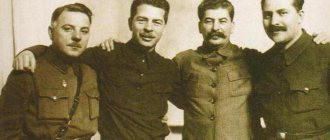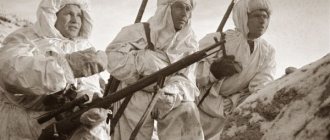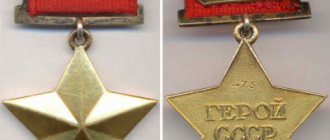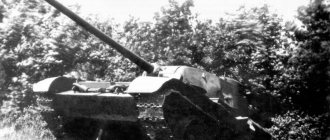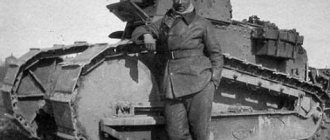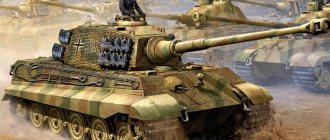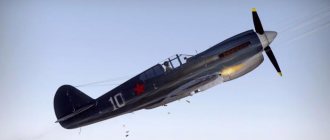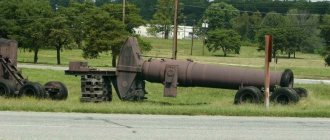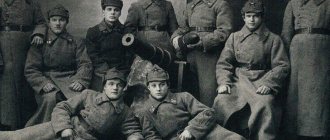The Battle of the Dnieper is a series of closely related offensive operations by the Red Army carried out in 1943 in Ukraine. The time range of these operations is August – December 1943.
The German command wanted to turn the Dnieper into the main part of the Eastern Wall defensive line. He had to finally stop the advance of Soviet troops to the west. Here they planned to exhaust them with defensive battles, and then persuade the USSR leadership to conclude peace. The command of the Red Army sought to cross the Dnieper as quickly as possible - without allowing the enemy to gain a thorough foothold on the high western bank.
The Battle of the Dnieper briefly
Soviet troops sought to capture and hold numerous bridgeheads on the Dnieper - so that from the most promising of them they could develop an offensive into the depths of Right Bank Ukraine.
An important milestone in the Battle of the Dnieper in 1943 was the liberation of Kyiv from the occupiers (November 6). It was made possible by the unexpected maneuver of the 3rd Tank Army of General Rybalko and several large formations of infantry and artillery.
Liberation of Kiev 1943
While the 91st Tank Brigade simulated an offensive for a week, secretly deployed troops were able to suddenly attack the enemies from the other side - from the north of the capital of Soviet Ukraine. Thanks to this stage of the battle on the Dnieper, it was possible not only to take Kyiv, but also to develop an offensive far into the enemy’s defense.
The final stage of the Battle of the Dnieper can be called the events of 1944: this was the encirclement and defeat of a large German group in Korsun-Shevchenkovsky, when the invaders were finally driven out from the last site on the banks of the Dnieper.
Battle of the Dnieper - participants, commanders, balance of forces and beginning
The operation was carried out by forces of two fronts (Voronezh and Stepnoy, renamed 1st and 2nd Ukrainian). They were commanded by Vatutin and Konev. The troops of the Central Front (Rokossovsky) were partially involved. In total, more than 2.5 million fighters. Their actions were coordinated by Zhukov. They were opposed by Army Group South (more than 2.4 million soldiers), commanded by Field Marshal General Manstein. To the south, in the Zaporozhye region, Malinovsky's Southwestern Front was advancing. But there the German defense line did not run along the Dnieper.
Soviet troops in ambush
In general, the plan of the Soviet command worked: the Germans did not have time to properly gain a foothold and make the “Eastern Wall” on the western bank of the Dnieper impregnable. The date of crossing the Dnieper was September 22, when the soldiers of the 13th Army were the first to begin this. The first bridgehead on which they managed to gain a foothold was conquered at the confluence of the Dnieper and Pripyat.
On September 24, the Red Army soldiers managed to gain a foothold in another position, near Dneprodzerzhinsk, and on September 28 - near Kremenchug.
Smolensk: shield, key, springboard
It has long been known as the “shield city” and the “key” to Moscow. But most importantly, Smolensk was a springboard: for the invaders - into; for Russians - to the west. Back in the Time of Troubles, the city’s defenders heroically defended themselves against the troops of the Polish king Sigismund III for 20 months. And although the siege ended with the capture of the city, due to the losses suffered near Smolensk, Sigismund’s army was unable to move to Moscow to help the Polish garrison and retreated to the Polish-Lithuanian Commonwealth.
The Great Patriotic War was no exception. The main blow in 1941 was delivered by the German command in the Moscow direction. It was on Smolensk soil that in the summer and autumn the famous German blitzkrieg, the plan for a lightning war with the capture of Moscow before the onset of cold weather, seriously and fatally stalled.
German plan for occupied Smolensk 1943
The most powerful blow of Army Group Center came here, and here the enemy first encountered stubborn and organized resistance from the previously retreating Red Army, which relied on the feasible help of the people. The Nazis were forced to periodically go on the defensive, and lost two months in the Smolensk region. During this time, the Soviet command managed to bring up reserves from the depths of the country and prepare the Vyazemsk and Mozhaisk defense lines of the capital.
And yet, events then developed in a tragic way for the Red Army - from the very moment when the German command decided to launch a new offensive in the Moscow direction using only mobile formations, without waiting for the approach of infantry divisions. For the Soviet command this came as a complete surprise. Our troops simply did not have time to take up defensive positions - neither the 19th Army of Lieutenant General Konev, which was unloaded in Liozno and Rudna to take up defense in the Vitebsk region, nor the 20th Army of Lieutenant General Kurochkin in the Orsha region, nor the 16th army of Lieutenant General Lukin in the Smolensk region.
Airborne operation in the Battle of the Dnieper
On the night of September 24-25, a Soviet airborne assault force was dropped on the western bank of the Dnieper. It was unsuccessful: due to difficult conditions and powerful anti-aircraft fire, most of the pilots lost their orientation and dropped the paratroopers in a different place than agreed. But even those who did not miss, due to dense anti-aircraft fire, threw parachutists from great heights and at high speed.
Soviet airborne assault
Therefore, the paratroopers found themselves scattered over a vast territory and were forced to fight alone or in small groups, with little ammunition. As a result, they suffered huge losses (3.5 thousand people out of 4,575 thrown behind enemy lines). But they diverted significant enemy forces to themselves, giving their own more opportunities to cross.
Crossing the Dnieper - briefly about the main thing
The crossing of the Dnieper by Soviet troops also did not go smoothly. The order was to cross the river on the move. But the Red Army units, stretched out on the march, had neither pontoons and watercraft, nor adequate air defense and artillery support.
We had to use any available means: wooden barrels, doors, boards and sticks from barns, fences, etc. All these watercraft were unsuitable for such a wide and deep river. Therefore, the soldiers not only died from enemy fire, but also drowned in icy water: it was impossible to swim out in heavy, wet uniforms.
Crossing the river by the Red Army
Those who managed to cross the Dnieper and gain a foothold in the bridgeheads held and gradually expanded them at the cost of heavy losses, under the unpunished fire of enemy aviation and artillery, which for the time being dominated the Battle of the Dnieper. However, dozens of bridgeheads captured after the crossing of the Dnieper at the end of September - October 1943 served as the basis for the accumulation of forces and further offensive in the Ukrainian Right Bank. All the Germans’ plans to create an impregnable “Eastern Wall” on the high bank of the Dnieper failed miserably.
Summer 1941. The capture of Smolensk by the Germans resulted in the collapse of the Barbarossa plan.
The Battle of Smolensk began on July 10, 1941, and a week later, on July 16, the 29th Motorized Division from General Guderian's 2nd Panzer Group broke into the outskirts of the city.
For Stalin, the sudden appearance of the Nazis in Smolensk caused shock and anger. On the same day, a formidable order was issued by the State Defense Committee, in which the command of the Western Front was required to suppress evacuation sentiments among soldiers and commanders with an iron fist “and order the units defending Smolensk not to surrender Smolensk to the enemy under any circumstances.”
This is what General Mikhail Lukin said about those days already in the 60s in an interview with Konstantin Simonov: “The summer was hot. But it was hot not only from the sun. The enemy, feeling that we are retreating, keeps pressing on us. This is where the heroism of our people showed itself. We have already disbanded all the officers of the headquarters, political department, army - corps as unnecessary, poured it all into divisions; all the convoys were cleared, everything was thrown into the units to fight. All the commanders of headquarters, political departments, divisions, regiments - everyone was on the front line. Every attack was met with a counterattack. They responded, but, unfortunately, with little support from artillery and mortars.”
On July 19, Guderian's 10th Panzer Division captured Yelnya, a small town 77 kilometers southeast of Smolensk, but further German advance was stopped. However, as a result of the attacks of the tank groups of Guderian and Hoth, three Soviet armies were immediately surrounded - the 19th, 20th and 16th.
“I gave the order - artillery has the right to fire only on the orders of the regiment commander at clearly visible targets and at tanks; in other cases, the artillery did not have the right to open fire. Only a few shells. But the tanks are advancing all the time, the aircraft are flying all the time,” said General Lukin.
Fierce urban fighting broke out in Smolensk, which lasted almost two weeks. Until July 28, when the Germans brought two fresh corps into action - the 8th and 20th. Under these conditions, the defenders of the city, who did not receive reserves, had to leave the city.
Do you remember, Alyosha, the roads of the Smolensk region, How the endless, angry rains fell, How tired women carried krinkas to us, Pressing them like children from the rain to their chests, How they wiped away their tears furtively, How they whispered after us: - Lord save you! - And again they called themselves soldiers, as was the custom in great Rus' of old. Measured by tears more often than by miles, the road went on, hiding from view on the hills: Villages, villages, villages with graveyards, As if all of Russia had converged on them, As if behind every Russian outskirts, Protecting the living with the cross of their hands, The whole world had come together, ours great-grandfathers pray for their grandchildren who do not believe in God...
Konstantin Simonov wrote this bitter poem in the summer of 1941, addressing another war correspondent and fellow soldier Alexei Surkov.
It would seem that the Smolensk battle is over. But in fact, this was only its first phase - three surrounded Soviet armies managed to escape from the cauldron and create a strong front east of the city. On July 30, 1941, the Wehrmacht command, in view of serious losses and the threat to the flanks from the Red Army, ordered the troops of Army Group Center to go on the defensive.
In the two-month Battle of Smolensk - from July 10 to September 10, 1941 - German troops suffered huge losses (250 thousand people) and were unable to turn large tank forces to the north. And this is the great merit of General Lukin, who was entrusted with organizing the defense of Smolensk. It was thanks to her that the Germans were unable to strike in the Rzhev-Kalinin direction in July-September, and at that time 60 days decided a lot.
However, along with the fighting in the city and its outskirts, the Soviet troops fighting in the direction of the main attack were threatened by another danger. In the Yelnya area, a protrusion towards Moscow was formed, which made it possible for the Nazis to encircle and destroy the main forces of the Western Front in the Smolensk area, and then launch an attack on the capital.
For 26 days there were stubborn and bloody battles for Yelnya, which ended on September 6 with one of the first indisputable victories of the USSR - the liberation of the city by Soviet troops. This, in turn, led to a strategic halt in the offensive against Moscow, which was planned to be carried out using only infantry divisions - and until September they were bogged down in positional battles with units of the Red Army. The idea of blitzkrieg was nullified, the Fuhrer began to completely change the scenario of the “eastern campaign”.
It took a lot of blood for the Red Army - more than 700 thousand soldiers and commanders were killed and wounded in the Battle of Smolensk. But Army Group Center, especially during the September counter-offensive of the Western, Reserve and Bryansk Fronts, suffered serious losses.
Battle for the Dnieper - results
The crossing of the Dnieper and subsequent battles on its right bank, despite all their severity, gave a huge number of examples of courage and bravery of Soviet soldiers and officers. In the Battle of the Dnieper, more than 2.4 thousand Red Army soldiers were awarded the title “Hero of the Soviet Union.” This is more than code ever; than even in the entire past history of this award.
There is no exact answer to the question: how many Soviet soldiers died during the crossing of the Dnieper. The losses were heavy; in those units that were directly involved in crossing, capturing and holding bridgeheads on the west bank, only 20-30% of the personnel remained.
Troops of the Red Army
According to official Soviet data, irretrievable losses alone amounted to over 400 thousand people. But the invaders also suffered heavy losses in the Battle of the Dnieper. According to Soviet data - also more than 400 thousand. According to German data - about 80 thousand killed and missing; more than 200 thousand were wounded.
Battle of the Dnieper map
The Battle of the Dnieper in 1943 was another major defeat for the Wehrmacht. The Red Army not only was not stopped at this line: it crossed one of the largest and deepest rivers on a broad front, and forced the Germans to retreat along this entire front. And the liberation from the invaders of Kyiv had enormous political, moral and economic significance.
News and events
December 23, 1941 185th day of the war
Battle for Leningrad.
Volkhov Front . Tikhvin operation. The 52nd Army reached the right bank of the Volkhov River, but due to the weakening and fatigue of the troops, it was unable to cross the river on the move.
Battle for Moscow.
Kalinin Front. Kalinin operation. The troops of the center and left wing of the front continued the offensive in the general direction of Staritsa, fighting with the enemy rearguards, and by the end of the day reached the line: Eremkino, Zaborovye, Afanasyevo, Emelyanovo, Kiselevo, Vakhnovo, Golovino.
Western Front . The right wing and the center of the front carried out the offensive, fulfilling the same task. On the left wing, Soviet troops pursued the fighting retreating enemy.
During the day, front troops liberated 43 settlements.
At 23 hours 50 minutes, the Military Council of the front gave a directive to the commander of the 16th Army “at any cost” to break through the enemy’s defenses on the Lama River and introduce the 2nd Guards Cavalry Corps, transferred to the army that day, into the breakthrough.
A similar order was given to the commander of the 20th Army, from whom the Front Military Council demanded to break through the enemy defenses at the Volokolamsk station.
Formations and units of the right wing of the 43rd Army, commanded by Major General K.D., a native of Petrovsk, Saratov Region. Golubev, fought unsuccessful battles, trying to break through the enemy’s defenses. The enemy, having strongly fortified the settlements of Iklinskoye, Aristovo, Alopovo, Romanovo, Nikolskie Dvory, provided powerful fire resistance to the advancing army troops.
Bryansk front. The front troops continued the offensive in the Oryol direction, but having encountered stubborn enemy resistance at the turn of the Zusha River, in the Verkhovye and Livny areas, they had almost no progress.
Southwestern Front. Front troops with the 40th Army launched an offensive in the Kursk direction. Due to the stubborn resistance of the enemy, the advancing units were not successful. The enemy repeatedly launched counterattacks, as a result of which the 45th Rifle Division on its right flank retreated to Baklanovka.
Southern front. Front troops with the forces of the right-flank 12th Army continued the offensive. The enemy offered fierce resistance to the advancing army units, repeatedly launching counterattacks.
December 23 , 1942 . 550th day of the war
Battle of Stalingrad.
Stalingrad front. Front troops fought actively to improve their positions in the zones of the 62nd, 2nd Guards and 51st armies.
The 62nd Army, operating in Stalingrad, with the forces of the 138th Infantry Division continued its offensive in a southwestern direction. Two buildings were blown up, and 30 enemy soldiers were killed in one of them. The enemy launched counterattacks twice. The battle of other assault groups continued to take possession of a large rectangular building on the banks of the Volga. The 95th Infantry Division of the same army continued its offensive in the northwestern direction. During the day, both rifle formations advanced 50-80 meters.
Army losses were 59 killed and 169 wounded.
The numerical composition of the formations of the 5th Shock Army: 315th Rifle Division - 8904 people, 300th Rifle Division - 7752 people, 4th Guards Rifle Division - 3777 people, 258th Rifle Division - 3905 people, 3rd Guards cavalry corps - 12,707 people.
Southwestern Front. Middle Don operation . The 17th Tank Corps of the 6th Army conducted military operations to capture the settlements of Voloshino and Sulin.
Battle for the Caucasus.
Transcaucasian front. Northern Group of Forces. The troops of the group, commanded by a native of the Chalykla station in the Saratov region, Lieutenant General I.I. Maslennikov, continued offensive battles in the Mozdok direction with units of the 4th Guards Cavalry Corps and the 44th Army. In the Alagir direction, in the morning the troops of the 9th Army went on the offensive.
In the Mozdok direction, the enemy, offering stubborn resistance, launched counterattacks. In the Alagir direction, the enemy, hiding behind rearguards, retreated in a northwestern direction.
December 23 , 1943. 915th day of the war
1st Baltic Front. Gorodok operation . At 11 o'clock artillery preparation began before the assault on Gorodok. After an hour-long artillery bombardment of the enemy defense, the 11th Guards and 43rd Armies went on the offensive. The attacking units broke into the fortifications of the enemy's third defensive line in several key directions, and then everywhere. Fierce hand-to-hand fighting broke out in the trenches and communication passages.
2nd Baltic Front. From 8 a.m., the troops of the left flank of the 6th Guards Army resumed their offensive in the northern and eastern directions with the task of destroying the enemy west of Lake Usvoya. Overcoming stubborn enemy resistance, supported by strong artillery and mortar fire, by the end of the day, army units advanced 2 - 4 kilometers and liberated 11 settlements.
Western Front. At 10 o'clock in the morning, after a 20-minute artillery barrage, the front forces of the 33rd Army went on the offensive. By the end of the day, the army’s strike force had broken through the front line of the enemy’s defenses, advanced 1.5 - 2.5 kilometers and captured 11 settlements.
Battle of the Dnieper.
Belorussian Front. The front forces of the 65th Army continued to conduct intense defensive battles southeast of the town of Parichi and part of the forces of the 63rd Army went on the offensive in the morning.
In order to divert the enemy's attention from the Parichi direction, at 12:30 p.m., after powerful artillery preparation, formations of the 63rd Army went on the offensive. Having broken the stubborn resistance of the enemy, and repelling his repeated counterattacks, the advancing units of the army advanced up to 2 kilometers, occupying Malye Kozlovichi and height 147.6.
The army's losses were 215 killed and 562 wounded.
In the defense zone of the 65th Army, the enemy from the Aleksandrovka region, with the forces of three infantry regiments with 80 tanks and 30 armored vehicles, resumed the offensive in a south-eastern direction. Another enemy group consisting of up to two infantry regiments with 60 tanks and 20 armored vehicles, supported by self-propelled guns, attacked units of the 27th Rifle Corps and pushed them back 2 to 10 kilometers.
1st Ukrainian Front. Front troops continued fighting on their right flank with the forces of the 13th, 60th and 1st Guards armies.
Units of the 13th Army fought with varying success in the areas of Kharitonovka and Stremingorod.
The 60th Army, with its right flank, fought with attacking enemy tank groups. During the day, in the grove area west of Peremog Meleni, units of the 23rd Rifle Corps repulsed six enemy counterattacks launched by forces up to an infantry battalion with 10-15 tanks and armored vehicles.
In the defense zone of the 127th Rifle Division of the 107th Rifle Corps of the 1st Guards Army, the enemy, after a strong fire attack by two infantry battalions and 25-30 tanks, went on the offensive and knocked out division units from two settlements. An attempt to restore the situation, made by two regiments of the 127th and 316th rifle divisions, was unsuccessful.
The 3rd Guards Tank Army had 234 tanks and 92 self-propelled artillery units in service.
2nd Ukrainian Front. Front troops repelled private enemy counterattacks in the Malaya Novgorodka area.
The battle for the Dnieper ended. The Red Army troops achieved major military and political results. An attempt by the German command to stop them on the so-called “Eastern Wall” was thwarted. The Red Army broke through this defensive line and created two important strategic bridgeheads on the right bank of the Dnieper: one in the area of Rechitsa, Korosten and Kyiv, the second in the Kirovograd and Krivoy Rog directions. These bridgeheads created favorable conditions for carrying out operations to liberate Belarus and the entire Right Bank Ukraine from the enemy. The enemy's plans to wage a protracted war on Soviet territory turned out to be untenable. During operations carried out in Ukraine, the Red Army inflicted a heavy defeat on the entire southern wing of the enemy front. From the end of August to December 1943, it defeated over 60 enemy divisions, including 11 tank and tank-grenadier divisions. The enemy suffered significant losses, especially in tanks, artillery and aircraft. But the losses of Soviet troops in the battle for the Dnieper were great: irrevocable - 417,323 people, sanitary - 1,269,841 people.
December 23 , 1944. 1281st day of war
2nd Baltic Front. The troops of the right wing of the front, with the forces of the 1st Shock and 22nd armies, at 11 a.m., after powerful artillery and air preparation, went on the offensive in the general direction of Lestene.
During the day, the troops of the right wing of the front, overcoming numerous minefields and engineering obstacles, fought stubborn battles with the enemy, who offered fierce resistance with fire and continuous counterattacks.
As a result of the fighting, the advancing Soviet units completely broke through the first, and in some areas, the second position of the enemy’s defense and advanced to a depth of 3.5 kilometers.
On the left wing of the front, having repelled numerous enemy counterattacks in the first half of the day, the troops of the 42nd and 10th Guards Armies resumed their offensive at 2 p.m.
Having encountered increased enemy resistance, the advancing units of the 42nd Army were unsuccessful, and the troops of the 10th Guards Army, after stubborn battles, advanced 1.5 kilometers into the depths of the enemy defense.
During the day, front troops liberated 33 settlements.
3rd Ukrainian Front. Budapest operation . The front troops, having broken the fierce resistance of the enemy, and having repelled all enemy counterattacks, advanced from 7 to 14 kilometers, captured 140 settlements, including the ancient capital of Hungary - the largest economic center of the country, the most important junction of highways and railways - the city of Székesfehérvár. The city was taken by formations and units of the 4th Guards Army, commanded by General of the Army G.F., a native of the village of Shilovo, Saratov Region. Zakharov.
In addition, in the area of the Hertseghalom station, parts of the 2nd Guards Mechanized Corps under the command of another Saratov resident, a native of the village of Chiganak, Lieutenant General K.V. Sviridov, they cut the highway and railway from Budapest to Bichke.
Thus, the front troops completed the breakthrough of the enemy’s tactical defense, moving forward to 30 kilometers and expanding the breakthrough area to 100 kilometers.
Sources:
Materials from the Internet sites “Wikipedia”, “Ministry of Defense of the Russian Federation” and “Memory of the People” (Journals of combat operations of the Kalinin, Western, South-Western and Southern fronts for December 1941; Stalingrad and Transcaucasian fronts for December 1942; 2nd Baltic, Western, Belorussian, 1st and 2nd Ukrainian Fronts for December 1943, 2nd Baltic and 3rd Ukrainian Fronts for December 1944).
Directory “Liberation of Cities: A Guide to the Liberation of Cities during the Great Patriotic War of 1941–1945” - M.: Voenizdat, 1985.

